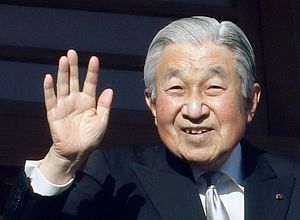Japanese Emperor Akihito waved on Wednesday to throngs of well-wishers eager to see his final New Year’s appearance before abdicating in April 2019.
“I am truly happy to celebrate the New Year with all of you under such cloudless skies,” the 85-year-old emperor told the crowd from a balcony at the Imperial Palace in Tokyo.
Akihito has made annual New Year’s appearances with his wife, Empress Michiko, and other family members to wish peace for the nation.
Japanese media reported that more than 150,000 people attended on Wednesday, a record under Akihito’s reign. Many waited from early in the morning and waved Japanese flags when Akihito appeared.
Akihito succeeded his father, wartime Emperor Hirohito, in 1989, and will abdicate on April 30, with his elder son, Naruhito, ascending to the Chrysanthemum Throne.
Japan’s imperial family is far more cloistered than its Western counterparts. Hirohito was once viewed as a god, but Akihito strove to become a more accessible emperor. He was the first in modern history to marry a commoner, courting Michiko on the tennis courts. Both of his sons have married commoners.
His abdication is also a rarity. He announced his desire to step down in a video message, citing a worry about how well he could perform his duties as his health declined.
Akihito appeared to wobble during a palace event earlier this week to greet foreign dignitaries. Michiko reached out worriedly and held up his arm with hers.
His abdication could have political implications for Japan, complicating Prime Minister Shinzo Abe’s desire to amend Japan’s pacifist constitution to formally legalize the existence of the Japan Self-Defense Force, the country’s military. Akihito has long been a champion of peace and reconciliation, frequently expressing “deep remorse” for Japan’s wartime aggression.
Akihito’s three-decade reign is known in Japan as “Heisei,” with the first character meaning “peace.” A senior politician in the ruling coalition said Wednesday that a name for the new era will be announced on April 1.
Crown Prince Naruhito appeared on the balcony with his wife, Masako, who was smiling and wearing a burgundy dress. She has missed some events over the years due to what palace officials have described as a stress-related illness, which is widely attributed to the pressures of palace life.
The Harvard-educated former diplomat expressed a desire to fulfill more of her duties in a statement released through the palace last month. She noted she had accompanied Naruhito in May to a Red Cross event she had missed for the last 15 years.
“The warm feelings of the people have helped me greatly,” she said of her recovery, hinting she may try to be more visible, as many had hoped when she gave up her career to enter the palace.
The public is closely watching to see how the younger and more international couple might bring more openness to a role that holds no political power but is widely recognized as a cultural and emotional symbol for Japan.
Naruhito, 58, attended Oxford, speaks good English, plays the cello and has vowed to “protect Masako.”
Naruhito’s younger brother and his family are also expected to play a fairly major role. The Japanese throne is only inherited by male heirs, and Naruhito’s only child is a daughter. Prince Akishino and his young son are next in the line of succession after Naruhito.
By Yuri Kageyama for the Associated Press, with additional reporting from The Diplomat.

































